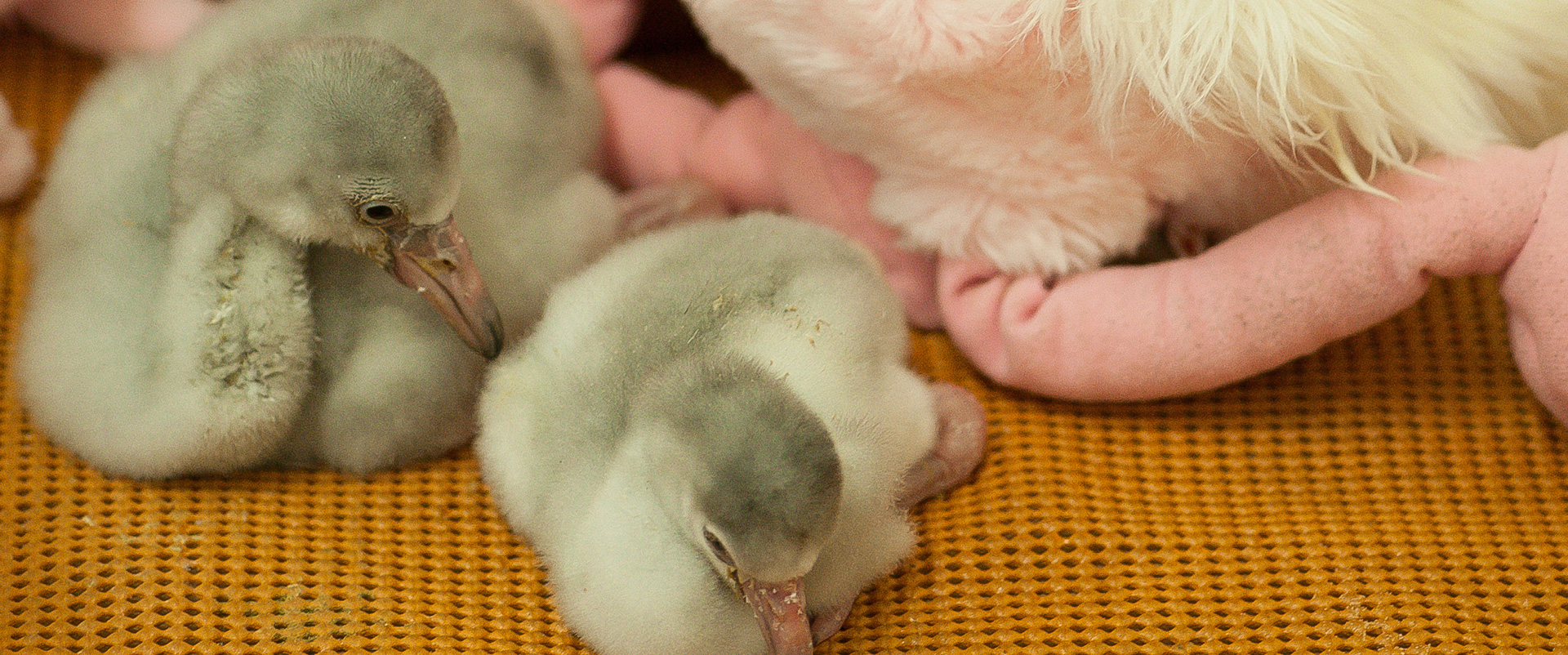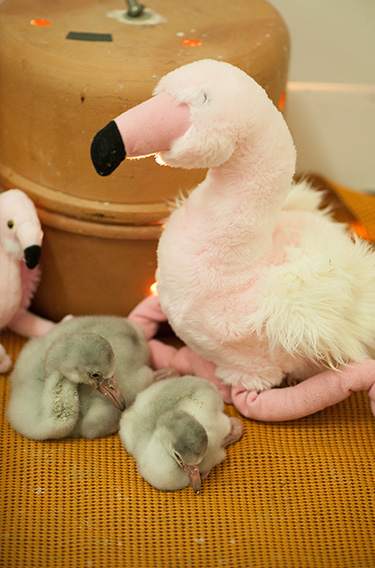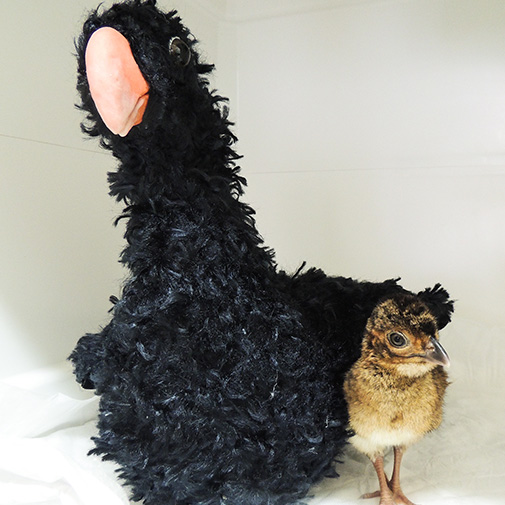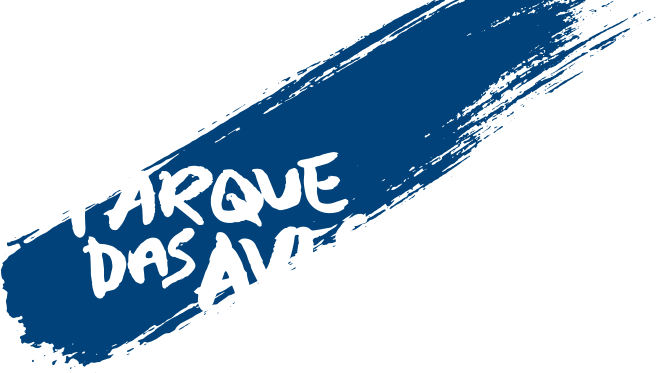


EXPERTISE IN REPRODUCTIVE MANAGEMENT
With the purpose of reproducing individuals of species threatened with extinction and by this optimize the efforts of the ex situ component in integrated conservation actions, Parque das Aves follows recommendations established by the studbook keepers for putting together couples whenever they are available. In cases of reproductive success, Parque das Aves concentrates all of its efforts in the survival of the chick, advocating natural raising whenever possible. However, if some type of human intervention is recommended in caring for the chick by recommendation of the management plans, committees, captivity programs, or in the absence of parental care or by veterinary recommendation, the birds may be kept in our Baby Bird Room. In this environment there are five animal treatment units whose temperature and humidity are controlled to keep the chicks in immediately after birth. Three technicians are involved exclusively in this environment who perform the neonatal care activities. Once the chicks leave the treatment units, they are then kept in premises with constant monitoring until they reach the age required to go back to the external enclosures with individuals of the same species. This team is also responsible for monitoring the eggs kept in incubators and to forecast births in the incubation room. Thermometers and hygrometers are used at this site to control the temperature and humidity in the environment in order to avoid sharp oscillations, which are not desirable for the development of the offspring. Various devices are used for monitoring the embryonic development of the eggs incubated in the room such as candling lamp, fetal heartbeat detector (Buddy®), precision scales, and vernier caliper. These data make it possible to keep electronic records related to the reproductive periods, as well as hatching date estimates and for following the curve of the weight of the eggs.

 |
EXPERTISE IN REPRODUCTIVE MANAGEMENT |

With the purpose of reproducing individuals of species threatened with extinction and by this optimize the efforts of the ex situ component in integrated conservation actions, Parque das Aves follows recommendations established by the studbook keepers for putting together couples whenever they are available. In cases of reproductive success, Parque das Aves concentrates all of its efforts in the survival of the chick, advocating natural raising whenever possible. However, if some type of human intervention is recommended in caring for the chick by recommendation of the management plans, committees, captivity programs, or in the absence of parental care or by veterinary recommendation, the birds may be kept in our Baby Bird Room. In this environment there are five animal treatment units whose temperature and humidity are controlled to keep the chicks in immediately after birth. Three technicians are involved exclusively in this environment who perform the neonatal care activities. Once the chicks leave the treatment units, they are then kept in premises with constant monitoring until they reach the age required to go back to the external enclosures with individuals of the same species. This team is also responsible for monitoring the eggs kept in incubators and to forecast births in the incubation room. Thermometers and hygrometers are used at this site to control the temperature and humidity in the environment in order to avoid sharp oscillations, which are not desirable for the development of the offspring. Various devices are used for monitoring the embryonic development of the eggs incubated in the room such as candling lamp, fetal heartbeat detector (Buddy®), precision scales, and vernier caliper. These data make it possible to keep electronic records related to the reproductive periods, as well as hatching date estimates and for following the curve of the weight of the eggs.
Parque das Aves has already been successful in the reproduction of 20 threatened or near threatened bird species. This is very important because to develop and constantly improve the reproduction techniques under human care is fundamental for a conservation breeding program.
List of threatened and near threatened species that we have reproduced:
Black-fronted Piping-Guan (Aburria jacutinga)
Red-tailed Amazon Parrot (Amazona brasiliensis)
Vinaceous-breasted Amazon Parrot (Amazona vinacea)
Hyacinth Macaw (Anodorhynchus hyacinthinus)
Sun Parakeet (Aratinga solstitialis)
Grey Crowned-Crane (Balearica regulorum)
Nicobar Pigeon (Caloenas nicobarica)
Red-billed Curassow (Crax blumenbachii)
Bare-faced Curassow (Crax fasciolata)
Azure Jay (Cyanocorax caeruleus)
Golden Parakeet (Guaruba guarouba)
Yellow Cardinal (Gubernatrix cristata)
Alagoas Curassow (Pauxi mitu)
Chilean Flamingo (Phoenicopterus chilensis)
White-Bellied Parrot (Pionites leucogaster)
Blue-winged Macaw (Primolius maracana)
Grey Parrot (Psittacus erithacus)
Saffron Toucanet (Pteroglossus bailloni)
Grey-breasted Parakeet (Pyrrhura griseipectus)
Greater Rhea (Rhea americana)
Solitary Tinamou (Tinamus solitarius)
Efficient conservation breeding programs seek to maximize the reproductive success of each individual through appropriate management. Parque das Aves is developing and improving its reproductive management techniques of endangered species, including the Yellow Cardinal (Gubernarix cristata) and the Alagoas Curassow (Pauxi mitu), which are part of National Action Plans.
Furthermore, many times the management techniques developed for not threatened species can be replicated for threatened species. Parque das Aves achieves excellent reproductive success especially with the following groups:
Psittaciformes – reproduction of 24 species
Cracidae – reproduction of 6 species
Ramphastidae – reproduction of 5 species
Strigidae – reproduction of 4 species
Parque das Aves is one of the few zoos in the world that has been successful in reproducing the Southern screamer (Chauna torquata) and the results have been published to help other institutions in managing these birds.
CLICK ON THE LINKS BESIDE AND LEARN MORE
 Every day from 8:30am to 5:30pm
Every day from 8:30am to 5:30pm Prices
Prices


